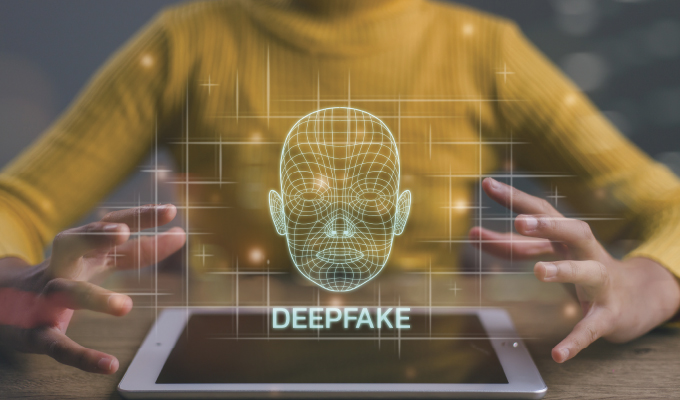AI is benefiting the construction industry by streamlining workflows. AI tools are being used to reduce human error, ensure quality control, and improve safety and cost estimation.
The introduction of any new technology brings challenges and risks. AI can be used to create deepfakes, highly convincing AI-generated videos, audio clips, photos, text messages, and other media designed to deceive. These forms of media can have a major impact on a company, delaying projects, damaging reputations, and affecting competitive edge.
Imagine if a fake, AI-generated video showing a dangerous safety violation on a project site began spreading on the internet right before a large contract was about to be signed. It sounds alarmist, but anyone with access to the internet can use AI tools to create deepfakes and spread misinformation. A recent AI tool called Sora, created by Open AI, is an AI model that can create realistic and imaginative videos from simple text instructions. When Sora was launched, one of the first deepfake examples it shared was of an active construction site. One sentence is all it can take to transform a generic video into a misleading deepfake. Imagine if someone used text instructions to add a worker wearing a shirt with a company name on it doing something inappropriate.
Industry leaders need to know how to defend against deepfakes and how to react if their company is targeted.
Construction leaders can use the following strategies to help eliminate risk and prepare for the threat of deepfakes.
CONFIRM THE DEEPFAKE IS, IN FACT, A FAKE
If an employee suspects a piece of media being spread across the internet is a deepfake, company leaders need to validate if it’s real or fake as soon as possible. People love sharing rumors and gossip, so you need to close it down quickly if it is in fact, fake. While some IT departments may have skilled employees who can recognize a fake video, your organization will have a much easier time convincing others that it is a deepfake if a third-party expert says it’s not real. There are a few deepfake detection companies around the globe that have developed software which can determine if the media has been manipulated. Identify and secure a relationship with one or more of these companies before you need them, as every hour matters when trying to protect your company’s reputation.
RESPOND QUICKLY AND KEEP MESSAGING CONSISTENT
In any crisis, a quick response will prevent further misinformation from spreading and show that the company is engaged with customers and already working to fix the issue. As a crisis professional, I urge executives to prepare key messages before a crisis hits. This is usually referred to as a company’s crisis playbook—a guide of key messages and steps that a company has prepared to respond to any potential crisis. This playbook will arm company leaders with a plan that can be implemented immediately while all the facts are still being investigated.
In addition to responding to a crisis quickly, companies should designate a single spokesperson to ensure consistency and acknowledge questions quickly in case reporters call. It’s important that companies maintain a single spokesperson so that responses to reporters can be made efficiently and with control.
KEEP EMPLOYEES INFORMED
When a crisis hits, company leaders need to listen, acknowledge, and investigate. Employees in the office and on job sites need to be updated to avoid accidentally spreading misinformation. A crisis also can be a confusing and scary time for customers, therefore staff must be ready to communicate with angry or concerned customers. Leaders should immediately hold meetings to ensure that everyone is on board quickly and that key messaging is shared as soon as possible.
In most cases, a deepfake will be detected by an employee before company leadership. It’s crucial to train employees to be on the lookout for false information and report anything suspicious to company leaders and the I.T. department. Employees should be trained to never share misinformation about the company on social channels.
INFORM STAKEHOLDERS AND PARTNERS
Transparency is important during a crisis. Be honest and direct with stakeholders about what’s happening. Depending on the severity of the deepfake, leaders might also consider telling subcontractors, union representatives, and other partners. Acknowledge the issue, even if it’s just to say that the company is investigating it. Provide expectations and instructions on what people should do and give consistent updates until the issue is resolved.
STAY AWARE OF MEDIA TRENDS AND MENTIONS
It’s vital to stay aware of industry trends and monitor how your company is mentioned in the media. Whether it’s on social media, TV news, print publications, or even radio, consistent monitoring for digital misinformation is key to preparing for a crisis. Stay aware of your company’s public image. Digital deception in the form of deepfakes uses existing information and manipulates it to be false. If your company is already aware of what is circulating the internet, then it will be easier to spot false information quicker, resulting in better control of your company’s reputation.
Companies should embrace AI for internal and external workflows. However, leaders must be prepared for AI crises such as deepfakes. Current crisis communication playbooks must be updated to implement AI crisis scenarios. As deepfake threats rise, updating strategy documents will be key to maintaining business. If your company falls under attack, updated crisis communications plans must be ready to be sprung into action.

About the Author:
Josh Weiss has worked 25+ years in the PR industry and is the President and founder of 10 to 1 Public Relations, a Scottsdale-based strategic communications firm. He is also an expert in crisis communications management, having helped numerous companies through very difficult times. For more, contact josh@10to1pr.com or visit www.10to1pr.com/deepfakes.
Modern Contractor Solutions, April 2024
Did you enjoy this article?
Subscribe to the FREE Digital Edition of Modern Contractor Solutions magazine.



